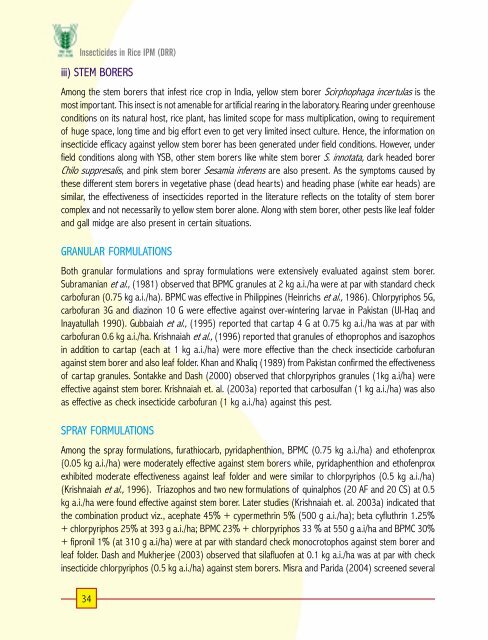priciples of insecticide use in rice ipm
priciples of insecticide use in rice ipm
priciples of insecticide use in rice ipm
You also want an ePaper? Increase the reach of your titles
YUMPU automatically turns print PDFs into web optimized ePapers that Google loves.
Insecticides <strong>in</strong> Rice IPM (DRR)<br />
iii) STEM BORERS<br />
Among the stem borers that <strong>in</strong>fest <strong>rice</strong> crop <strong>in</strong> India, yellow stem borer Scirphophaga <strong>in</strong>certulas is the<br />
most important. This <strong>in</strong>sect is not amenable for artificial rear<strong>in</strong>g <strong>in</strong> the laboratory. Rear<strong>in</strong>g under greenho<strong>use</strong><br />
conditions on its natural host, <strong>rice</strong> plant, has limited scope for mass multiplication, ow<strong>in</strong>g to requirement<br />
<strong>of</strong> huge space, long time and big effort even to get very limited <strong>in</strong>sect culture. Hence, the <strong>in</strong>formation on<br />
<strong><strong>in</strong>secticide</strong> efficacy aga<strong>in</strong>st yellow stem borer has been generated under field conditions. However, under<br />
field conditions along with YSB, other stem borers like white stem borer S. <strong>in</strong>notata, dark headed borer<br />
Chilo suppresalis, and p<strong>in</strong>k stem borer Sesamia <strong>in</strong>ferens are also present. As the symptoms ca<strong>use</strong>d by<br />
these different stem borers <strong>in</strong> vegetative phase (dead hearts) and head<strong>in</strong>g phase (white ear heads) are<br />
similar, the effectiveness <strong>of</strong> <strong><strong>in</strong>secticide</strong>s reported <strong>in</strong> the literature reflects on the totality <strong>of</strong> stem borer<br />
complex and not necessarily to yellow stem borer alone. Along with stem borer, other pests like leaf folder<br />
and gall midge are also present <strong>in</strong> certa<strong>in</strong> situations.<br />
GRANULAR FORMULATIONS<br />
Both granular formulations and spray formulations were extensively evaluated aga<strong>in</strong>st stem borer.<br />
Subramanian et al., (1981) observed that BPMC granules at 2 kg a.i./ha were at par with standard check<br />
carb<strong>of</strong>uran (0.75 kg a.i./ha). BPMC was effective <strong>in</strong> Philipp<strong>in</strong>es (He<strong>in</strong>richs et al., 1986). Chlorpyriphos 5G,<br />
carb<strong>of</strong>uran 3G and diaz<strong>in</strong>on 10 G were effective aga<strong>in</strong>st over-w<strong>in</strong>ter<strong>in</strong>g larvae <strong>in</strong> Pakistan (Ul-Haq and<br />
Inayatullah 1990). Gubbaiah et al., (1995) reported that cartap 4 G at 0.75 kg a.i./ha was at par with<br />
carb<strong>of</strong>uran 0.6 kg a.i./ha. Krishnaiah et al., (1996) reported that granules <strong>of</strong> ethoprophos and isazophos<br />
<strong>in</strong> addition to cartap (each at 1 kg a.i./ha) were more effective than the check <strong><strong>in</strong>secticide</strong> carb<strong>of</strong>uran<br />
aga<strong>in</strong>st stem borer and also leaf folder. Khan and Khaliq (1989) from Pakistan confirmed the effectiveness<br />
<strong>of</strong> cartap granules. Sontakke and Dash (2000) observed that chlorpyriphos granules (1kg a.i/ha) were<br />
effective aga<strong>in</strong>st stem borer. Krishnaiah et. al. (2003a) reported that carbosulfan (1 kg a.i./ha) was also<br />
as effective as check <strong><strong>in</strong>secticide</strong> carb<strong>of</strong>uran (1 kg a.i./ha) aga<strong>in</strong>st this pest.<br />
SPRAY FORMULATIONS<br />
Among the spray formulations, furathiocarb, pyridaphenthion, BPMC (0.75 kg a.i./ha) and eth<strong>of</strong>enprox<br />
(0.05 kg a.i./ha) were moderately effective aga<strong>in</strong>st stem borers while, pyridaphenthion and eth<strong>of</strong>enprox<br />
exhibited moderate effectiveness aga<strong>in</strong>st leaf folder and were similar to chlorpyriphos (0.5 kg a.i./ha)<br />
(Krishnaiah et al., 1996). Triazophos and two new formulations <strong>of</strong> qu<strong>in</strong>alphos (20 AF and 20 CS) at 0.5<br />
kg a.i./ha were found effective aga<strong>in</strong>st stem borer. Later studies (Krishnaiah et. al. 2003a) <strong>in</strong>dicated that<br />
the comb<strong>in</strong>ation product viz., acephate 45% + cypermethr<strong>in</strong> 5% (500 g a.i./ha); beta cyfluthr<strong>in</strong> 1.25%<br />
+ chlorpyriphos 25% at 393 g a.i./ha; BPMC 23% + chlorpyriphos 33 % at 550 g a.i/ha and BPMC 30%<br />
+ fipronil 1% (at 310 g a.i/ha) were at par with standard check monocrotophos aga<strong>in</strong>st stem borer and<br />
leaf folder. Dash and Mukherjee (2003) observed that silaflu<strong>of</strong>en at 0.1 kg a.i./ha was at par with check<br />
<strong><strong>in</strong>secticide</strong> chlorpyriphos (0.5 kg a.i./ha) aga<strong>in</strong>st stem borers. Misra and Parida (2004) screened several<br />
34











